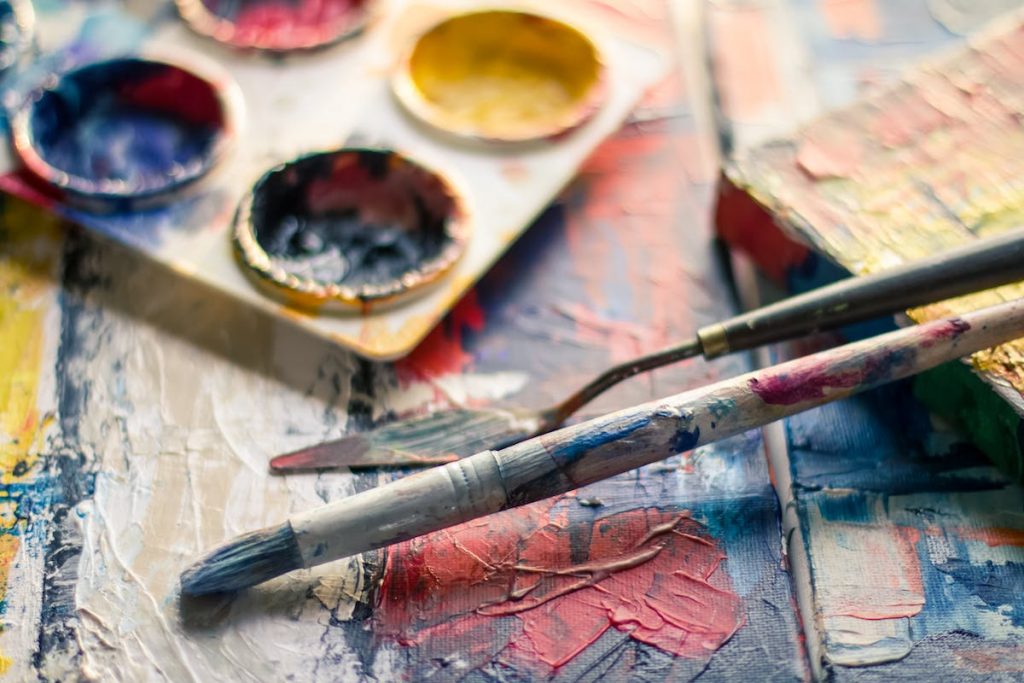- Crafting stories or poems and creative writing can improve critical thinking skills.
- Drawing or painting can boost hand-eye coordination and visualization abilities.
- Playing an instrument involves choosing the right one, practicing regularly, and learning music theory.
- Cooking engages the brain through planning, preparation, and execution of recipes.
- Solving puzzles like crosswords and word fill-ins can enhance vocabulary, problem-solving skills, and linguistic mastery.
As you navigate the complexities of daily life, it’s essential to keep your cognitive functions sharp. Engaging in creative activities isn’t just a leisure pursuit—it’s a way to enhance brain health and mental agility. By stimulating your mind with creative tasks, you can improve memory, enhance problem-solving skills, and maintain cognitive functions as you age. So, roll up your sleeves and prepare to challenge your brain in novel and exciting ways with these five creative activities.
1. Crafting a World with Words
Writing is a window to your imagination, a process that can significantly boost cognitive functions. Start by setting aside a few minutes each day to journal. It doesn’t have to be a daunting task; even jotting down your thoughts, feelings, or daily experiences can be beneficial.
To take it a step further, engage in creative writing. Craft stories or poems, play with words, build characters, or describe imaginary worlds. Constructing narratives enhances your ability to think critically and expressively, giving your cognitive abilities a well-rounded workout.
2. The Artistic Mind Gym

Artistic expression comes in many forms, and each one can serve as a cognitive enhancer. You might begin with drawing or painting, which can improve hand-eye coordination and stimulate visualization skills. Choose subjects that are meaningful to you or let your emotions guide your color choices and brush strokes.
Alternatively, sculpture or pottery can be a tactile and rewarding way to boost cognitive function. The three-dimensional aspect of these art forms requires spatial reasoning and planning, providing a challenging yet therapeutic way to enhance mental capacity.
3. Musical Harmonies for Mental Health
Learning to play a musical instrument is like a full-body workout for the brain. Here are tips to play a musical instrument:
Choosing the Right Instrument
Choosing the right musical instrument is a personal journey. Reflect on your musical preferences and consider the practicality of the instrument. Think about your lifestyle, the space you have available, and the time you can dedicate to practice. A guitar might be a good starting point for someone who loves rock or folk music, while a keyboard can be a versatile choice for those with diverse musical tastes.
Starting with Basics
Once you’ve chosen your instrument, begin with the basics. Learn how to hold the instrument correctly and familiarize yourself with its different parts. Start practicing simple scales and chords and gradually progress to more complex pieces. Remember, patience and consistency are key in this learning process. There are plenty of online resources and tutorials that can help guide you along this musical journey.
Enrich Your Learning with Music Theory
While learning how to play an instrument, it’s beneficial to delve into music theory as well. Understanding the basics of key signatures, note values, and time signatures can enhance your music reading skills. Furthermore, it provides a deeper understanding of the structure and components of a piece of music, allowing you to appreciate and perform it more effectively.
Practicing Regularly and Mindfully
Regular and mindful practice is crucial to mastering a musical instrument. Spend quality time each day practicing, focusing not just on playing the notes but also on the dynamics and articulations of the piece. Recording your practice sessions and listening back can be a powerful tool for self-assessment and improvement. Remember, the goal is not just to play the notes correctly but to express the emotions and nuances that the music conveys.
4. Culinary Creations for Cognitive Enhancement

Cooking is an art form that requires a blend of creativity and precision, making it an excellent cognitive exercise. Experiment with new recipes or try to recreate dishes from your memory. The planning, preparation, and execution involved in cooking are all excellent cognitive stimulators.
Pair this activity with learning about the nutritional value of different ingredients, which engages the brain further and adds a layer of health benefits to the mix. As you measure, chop, and sauté, you’re not just crafting a meal—you’re nourishing your brain, too.
5. Puzzling Through Language
Puzzles are a classic brain training tool, and language puzzles are particularly adept at boosting cognitive function. Crossword puzzles, for example, require you to draw on your vocabulary and general knowledge, while anagrams challenge you to think flexibly and recognize patterns.
One specific type of language puzzle that can be incredibly engaging is a word puzzle fill in the blanks. This activity forces you to use context clues and your knowledge of language structure to find the right fit for each gap. Not only does it expand your vocabulary, but it also sharpens your problem-solving skills and enhances your linguistic dexterity.
Final Words
Keeping your cognitive functions active doesn’t have to be a tedious task. Through these creative and enjoyable activities, you are not just filling your free time—you’re also forging new neural pathways and enhancing your mental faculties. Whether it’s through weaving tales, painting vistas, harmonizing melodies, concocting feasts, or solving word puzzles, each activity brings its own set of benefits to the table.
So, choose the one that speaks to you the most, or better yet, rotate through them to give your brain the comprehensive workout it deserves. Remember, when it comes to your brain health, you’re the artist of its landscape—make it vibrant, make it challenging, and most importantly, make it fun.

